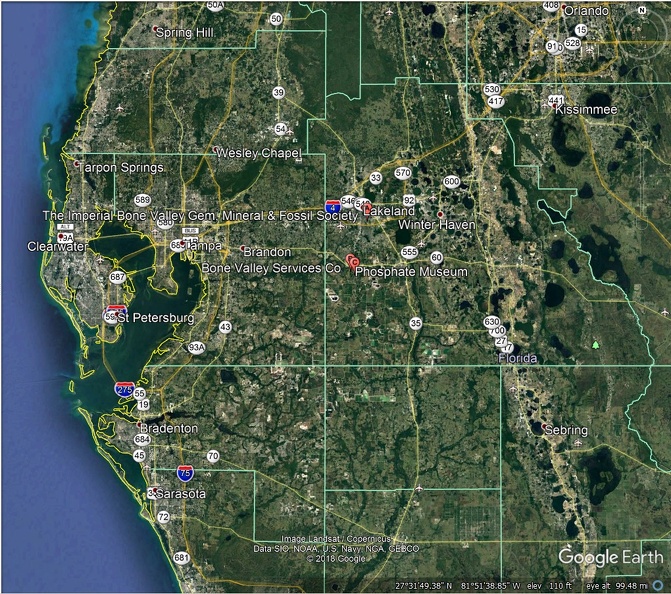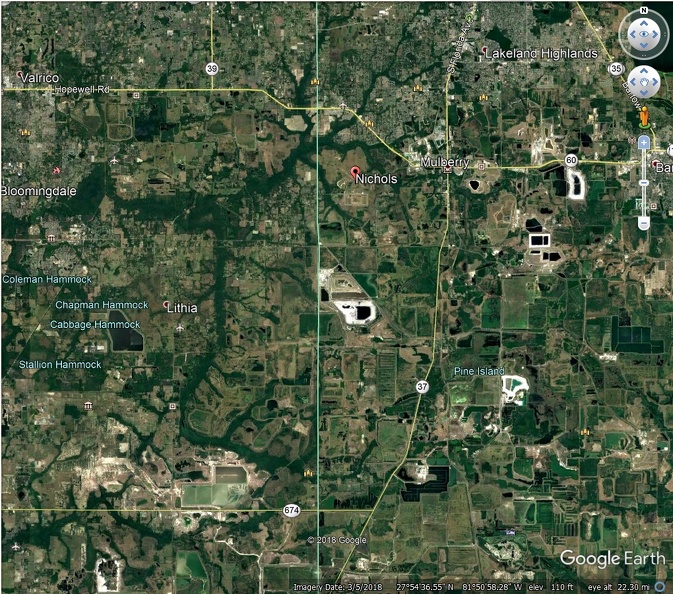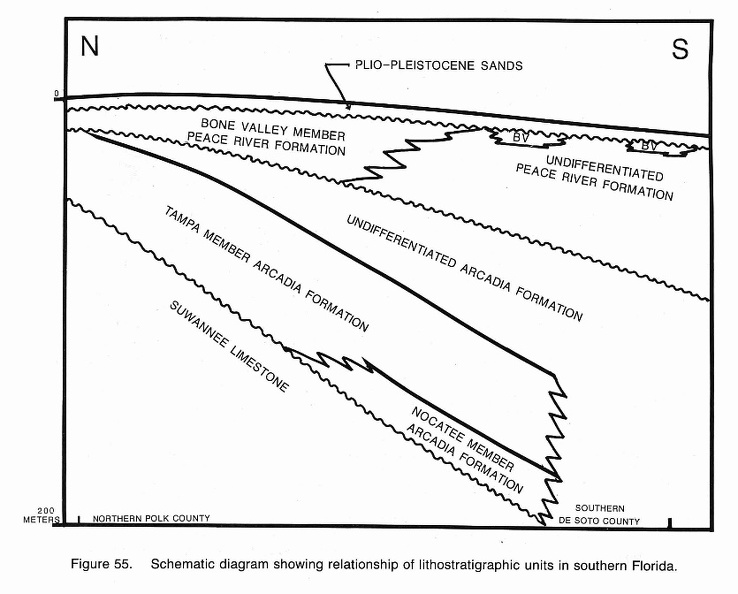Post by 1dave on Jul 11, 2018 6:43:31 GMT -5
en.wikipedia.org/wiki/Bone_Valley_Formation

en.wikipedia.org/wiki/Bone_Valley




The Bone Valley Formation is a geologic formation in Florida. It is sometimes classified as the upper member of the Peace River Formation of the Hawthorn Group.[2] It contains economically important phosphorite deposits that are mined in west-central Florida, as well as rich assemblages of vertebrate fossils.
Contents
1 Lithology
2 Age
3 Paleontology
4 See also
5 References
Lithology
The Bone Valley Formation consists of sandy marl that contains pebbles of phosphate and chert, fragments of bone, and other organic remains. The finer grained material is soft and plastic when wet, but hardens when dry.[1]
Age
The Bone Valley Formation contains mammal fossils and its age has been determined by mammalian biostratigraphy.
Period: Neogene
Epoch: Middle Miocene to Early Pliocene
North American land mammal age: Barstovian to Hemphillian[3]
Paleontology
The Bone Valley Formation includes a diverse assemblage of vertebrate fossils. These include remains of sea turtles,[4] equines,[5] felines,[6][7] peccaries,[8] and others.
See also
Earth sciences portal flagFlorida portal iconPaleontology portal Neogene portal Cenozoic portal
Bone Valley
List of fossiliferous stratigraphic units in Florida
Contents
1 Lithology
2 Age
3 Paleontology
4 See also
5 References
Lithology
The Bone Valley Formation consists of sandy marl that contains pebbles of phosphate and chert, fragments of bone, and other organic remains. The finer grained material is soft and plastic when wet, but hardens when dry.[1]
Age
The Bone Valley Formation contains mammal fossils and its age has been determined by mammalian biostratigraphy.
Period: Neogene
Epoch: Middle Miocene to Early Pliocene
North American land mammal age: Barstovian to Hemphillian[3]
Paleontology
The Bone Valley Formation includes a diverse assemblage of vertebrate fossils. These include remains of sea turtles,[4] equines,[5] felines,[6][7] peccaries,[8] and others.
See also
Earth sciences portal flagFlorida portal iconPaleontology portal Neogene portal Cenozoic portal
Bone Valley
List of fossiliferous stratigraphic units in Florida
en.wikipedia.org/wiki/Bone_Valley



The Bone Valley is a region of central Florida, encompassing portions of present-day Hardee, Hillsborough, Manatee, and Polk counties, in which phosphate is mined for use in the production of agricultural fertilizer. Florida currently contains the largest known deposits of phosphate in the United States.
Contents
1 Process
2 History
3 Rail Service
4 Risks of mining
5 See also
6 References
7 External links
Process
Rotary gondolas such as these are used by CSXT to transport phosphate rock from the Bone Valley region to transloading facilities along Tampa Bay -- Edison, Florida.
Large walking draglines, operating twenty-four hours a day in surface mines, excavate raw pebble phosphate mixed with clay and sand (known as matrix). The matrix contains a number of chemical impurities, including naturally occurring uranium at concentrations of approximately 100 ppm. Because this phosphogypsum is slightly radioactive, its use is banned in most situations.[1]
The matrix is then dropped into a pit where it is mixed with water to create a slurry, which is then pumped through miles of large steel pipes to washing plants. These plants crush, sift, and separate the phosphate from the sand, clay, and other materials, and mix in more water to create a granular rock termed wetrock. The wetrock, which is typically of little use in raw form, is then moved largely by rail to fertilizer plants where it is processed. The final products include, but are not limited to, diammonium phosphate (DAP), monoammonium phosphate (MAP) and trisodium phosphate (TSP).
Waste byproducts are stored in large phosphogypsum stacks and settling ponds, often hundreds of acres in size, and up to 200 feet (60.96 m) tall.
Phosphate processing produces significant amounts of fluorine gas, which must be treated by filtering through special scrubbers.
Much of the final product (known within the industry as 'dryrock') is transported by rail to facilities along Tampa Bay, where they are transloaded onto ships destined for countries such as China.
Phosphate product intended for domestic use is assembled into Unit trains of covered hopper cars for northbound movement.
History
When the narrow gauge[2] Florida Southern Railway reached Arcadia in 1886, it was a sleepy little town and the builders paused only briefly before pushing the railroad south to Punta Gorda. Unknown to the railroad and the general public at this time, a great discovery had been made in 1881 by Captain Francis LeBaron of the United States Army Corps of Engineers, who was surveying the lower Peace River area for a canal to connect the headwaters of the Saint Johns River to Charlotte Harbor. Here he found and shipped to the Smithsonian Institution nine barrels of prehistoric fossils from the sand bars prevalent on the lower Peace River. He also noticed that there was a phosphatase quality to the fossils and the deposit they were found in was very valuable. The Smithsonian wanted him to return and lead an expedition for prospecting more fossils, but Captain LeBaron was unable to return due to important duties at Fernandina where he was put in charge of harbor improvements.
In December 1886, LeBaron returned to the Peace River where he dug some test pits and sent the samples to a laboratory for analysis. The tests showed high quality bone phosphate of lime. LeBaron tried to interest investors in New York, Boston and Philadelphia, but none would invest in the project. Frustrated, he left the United States for the ill-fated Nicaraguan Canal Project.
The test results became known to Colonel G.W. Scott who owned the G.W. Scott Manufacturing Co. of Atlanta and he sent a representative to Arcadia who made several large purchases along the Peace River. Colonel T.S. Moorhead of Pennsylvania, who had also learned about the deposits from Captain LeBaron, but not the secret of their location, traveled to Arcadia where he stumbled onto the famous sand bars. Mr. Moorhead formed the Arcadia Phosphate Company, with the Scott Mfg. Co. quickly agreeing to purchase the entire output. The first shipment of Florida phosphate was made in May 1888 when the first ten car loads were dispatched to Scott's Fertilizer Works in Atlanta, Georgia. Soon after, G.W. Scott formed the Desoto Phosphate Co. at Zolfo where the Florida Southern Railway crossed the Peace River. The biggest player was the Peace River Phosphate Company (formed in January 1887) which was located in Arcadia by M.M. Knudson of New York and they built a narrow gauge railroad from the works on the river to the interchange with the Florida Southern. This company and its railroad were the first direct ancestor of the future Charlotte Harbor & Northern. The Peace River Phosphate Co. began mining in the Winter of 1889, and most of the ore was shipped to Punta Gorda via the Florida Southern, where it was loaded onto ships for export to Europe.
Early mining was with pick and shovel where the above-water sand bars were mined by hand. The material was carried on barges to the nearby drying works. Soon suction dredges were employed and the mining spread along the lower Peace River.
Moorhead soon sold his Arcadia Phosphate Co. to Hammond & Hull of Savannah, Georgia a large fertilizer operation in that city. Moorhead returned to Pennsylvania, where he developed a phosphate mine in Juniata County, PA and formed the narrow gauge Tuscarora Valley Railroad. Hammond & Hull also owned the Charlotte Harbor Phosphate Co. which had their works at Hull, connecting with the Florida Southern by a short branch line. To connect the two plants, Hammond & Hull built a narrow gauge railroad between Arcadia and Hull circa 1890. The railroad served various load-outs along the river, where the barges carrying pebble were unloaded into ore cars for the journey to the drying plants at Arcadia and Hull. Hammond dropped out around 1890 and the new firm was known as Comer & Hull.
The Peace River Phosphate Co. had built a narrow gauge railroad north of Arcadia to their load-outs along the Peace River. Like the Comer & Hull operations, the ore was hauled to the drying plant at Arcadia where it was loaded into the narrow gauge boxcars of the Florida Southern. When the railroad converted its Charlotte Harbor Division to standard gauge in 1892, both the Peace River Phosphate Co. and Comer & Hull operations converted their respective railroads. Joseph Hull of Comer & Hull purchased 50% interest in the Peace River Phosphate Co. about this time.
In December 1894, Joseph Hull consolidated the Arcadia Phosphate Co., Charlotte Harbor Phosphate Co., Desota Phosphate & Mining Co. & Peace River Phosphate Co. into the Peace River Phosphate Mining Co.
Peter Bradley of New York was one of the fertilizer capitalists (Bradley Fertilizer Co.) that Captain LeBaron had first approached about the sand bars. In May 1899, he was involved in the merger of 22 fertilizer companies into the American Agricultural Chemical Co., becoming vice president and a director of the new corporation.
AACC began buying the stock of the Peace River Phosphate Mining Co. from June 1899 until January 1902.
The Peace River Phosphate Mining Company Railroad consisted of a mainline running south from Arcadia to Liverpool. A few short branches connected the railroad to the Florida Southern (later the Plant System in 1896 and the ACL after 1902) at Arcadia, Hull and Liverpool. At Hull sand was removed by a washing plant. Liverpool housed the drying plant and barge loading facilities. A branch running north for about 3 miles (4.8 km) upstream from Arcadia served many load-outs along the river.
In the early years, phosphate from the Peace River area was barged to Punta Gorda, or shipped by rail to Port Tampa. Other important ports were later established at Seddon Island, Boca Grande, and Rockport.
Today Mosaic Inc. mines the area exclusively and is seeking to mine properties further south, in Hardee and Manatee Counties.
With renewed interest in corn-based ethanol fuel, the demand for fertilizer is expected to increase.
Contents
1 Process
2 History
3 Rail Service
4 Risks of mining
5 See also
6 References
7 External links
Process
Rotary gondolas such as these are used by CSXT to transport phosphate rock from the Bone Valley region to transloading facilities along Tampa Bay -- Edison, Florida.
Large walking draglines, operating twenty-four hours a day in surface mines, excavate raw pebble phosphate mixed with clay and sand (known as matrix). The matrix contains a number of chemical impurities, including naturally occurring uranium at concentrations of approximately 100 ppm. Because this phosphogypsum is slightly radioactive, its use is banned in most situations.[1]
The matrix is then dropped into a pit where it is mixed with water to create a slurry, which is then pumped through miles of large steel pipes to washing plants. These plants crush, sift, and separate the phosphate from the sand, clay, and other materials, and mix in more water to create a granular rock termed wetrock. The wetrock, which is typically of little use in raw form, is then moved largely by rail to fertilizer plants where it is processed. The final products include, but are not limited to, diammonium phosphate (DAP), monoammonium phosphate (MAP) and trisodium phosphate (TSP).
Waste byproducts are stored in large phosphogypsum stacks and settling ponds, often hundreds of acres in size, and up to 200 feet (60.96 m) tall.
Phosphate processing produces significant amounts of fluorine gas, which must be treated by filtering through special scrubbers.
Much of the final product (known within the industry as 'dryrock') is transported by rail to facilities along Tampa Bay, where they are transloaded onto ships destined for countries such as China.
Phosphate product intended for domestic use is assembled into Unit trains of covered hopper cars for northbound movement.
History
When the narrow gauge[2] Florida Southern Railway reached Arcadia in 1886, it was a sleepy little town and the builders paused only briefly before pushing the railroad south to Punta Gorda. Unknown to the railroad and the general public at this time, a great discovery had been made in 1881 by Captain Francis LeBaron of the United States Army Corps of Engineers, who was surveying the lower Peace River area for a canal to connect the headwaters of the Saint Johns River to Charlotte Harbor. Here he found and shipped to the Smithsonian Institution nine barrels of prehistoric fossils from the sand bars prevalent on the lower Peace River. He also noticed that there was a phosphatase quality to the fossils and the deposit they were found in was very valuable. The Smithsonian wanted him to return and lead an expedition for prospecting more fossils, but Captain LeBaron was unable to return due to important duties at Fernandina where he was put in charge of harbor improvements.
In December 1886, LeBaron returned to the Peace River where he dug some test pits and sent the samples to a laboratory for analysis. The tests showed high quality bone phosphate of lime. LeBaron tried to interest investors in New York, Boston and Philadelphia, but none would invest in the project. Frustrated, he left the United States for the ill-fated Nicaraguan Canal Project.
The test results became known to Colonel G.W. Scott who owned the G.W. Scott Manufacturing Co. of Atlanta and he sent a representative to Arcadia who made several large purchases along the Peace River. Colonel T.S. Moorhead of Pennsylvania, who had also learned about the deposits from Captain LeBaron, but not the secret of their location, traveled to Arcadia where he stumbled onto the famous sand bars. Mr. Moorhead formed the Arcadia Phosphate Company, with the Scott Mfg. Co. quickly agreeing to purchase the entire output. The first shipment of Florida phosphate was made in May 1888 when the first ten car loads were dispatched to Scott's Fertilizer Works in Atlanta, Georgia. Soon after, G.W. Scott formed the Desoto Phosphate Co. at Zolfo where the Florida Southern Railway crossed the Peace River. The biggest player was the Peace River Phosphate Company (formed in January 1887) which was located in Arcadia by M.M. Knudson of New York and they built a narrow gauge railroad from the works on the river to the interchange with the Florida Southern. This company and its railroad were the first direct ancestor of the future Charlotte Harbor & Northern. The Peace River Phosphate Co. began mining in the Winter of 1889, and most of the ore was shipped to Punta Gorda via the Florida Southern, where it was loaded onto ships for export to Europe.
Early mining was with pick and shovel where the above-water sand bars were mined by hand. The material was carried on barges to the nearby drying works. Soon suction dredges were employed and the mining spread along the lower Peace River.
Moorhead soon sold his Arcadia Phosphate Co. to Hammond & Hull of Savannah, Georgia a large fertilizer operation in that city. Moorhead returned to Pennsylvania, where he developed a phosphate mine in Juniata County, PA and formed the narrow gauge Tuscarora Valley Railroad. Hammond & Hull also owned the Charlotte Harbor Phosphate Co. which had their works at Hull, connecting with the Florida Southern by a short branch line. To connect the two plants, Hammond & Hull built a narrow gauge railroad between Arcadia and Hull circa 1890. The railroad served various load-outs along the river, where the barges carrying pebble were unloaded into ore cars for the journey to the drying plants at Arcadia and Hull. Hammond dropped out around 1890 and the new firm was known as Comer & Hull.
The Peace River Phosphate Co. had built a narrow gauge railroad north of Arcadia to their load-outs along the Peace River. Like the Comer & Hull operations, the ore was hauled to the drying plant at Arcadia where it was loaded into the narrow gauge boxcars of the Florida Southern. When the railroad converted its Charlotte Harbor Division to standard gauge in 1892, both the Peace River Phosphate Co. and Comer & Hull operations converted their respective railroads. Joseph Hull of Comer & Hull purchased 50% interest in the Peace River Phosphate Co. about this time.
In December 1894, Joseph Hull consolidated the Arcadia Phosphate Co., Charlotte Harbor Phosphate Co., Desota Phosphate & Mining Co. & Peace River Phosphate Co. into the Peace River Phosphate Mining Co.
Peter Bradley of New York was one of the fertilizer capitalists (Bradley Fertilizer Co.) that Captain LeBaron had first approached about the sand bars. In May 1899, he was involved in the merger of 22 fertilizer companies into the American Agricultural Chemical Co., becoming vice president and a director of the new corporation.
AACC began buying the stock of the Peace River Phosphate Mining Co. from June 1899 until January 1902.
The Peace River Phosphate Mining Company Railroad consisted of a mainline running south from Arcadia to Liverpool. A few short branches connected the railroad to the Florida Southern (later the Plant System in 1896 and the ACL after 1902) at Arcadia, Hull and Liverpool. At Hull sand was removed by a washing plant. Liverpool housed the drying plant and barge loading facilities. A branch running north for about 3 miles (4.8 km) upstream from Arcadia served many load-outs along the river.
In the early years, phosphate from the Peace River area was barged to Punta Gorda, or shipped by rail to Port Tampa. Other important ports were later established at Seddon Island, Boca Grande, and Rockport.
Today Mosaic Inc. mines the area exclusively and is seeking to mine properties further south, in Hardee and Manatee Counties.
With renewed interest in corn-based ethanol fuel, the demand for fertilizer is expected to increase.
























